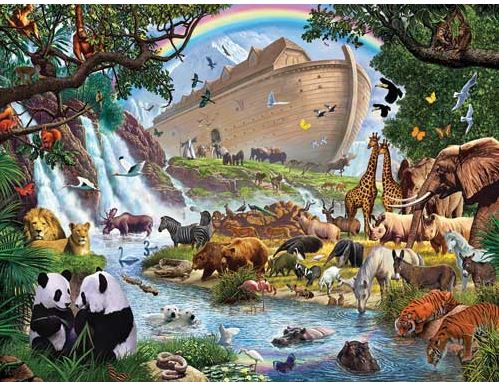The story of Noah is a spectacular display of God’s power and might. It shows that God has absolute control and authority over all creation and all life. Most importantly, it teaches that God’s divine providence never fails for those who loved Him and obeyed Him.
In the book of Genesis the Scriptures described how the Ark is to be built: with three decks, one side door, and one window. God gives Noah detailed instructions for building the Ark: it is to be made of cypress wood, coated inside and out with pitch, with three decks and internal compartments. It will be 450 feet long, 75 feet wide, and 45 feet high. It will also have a roof on it “finished to 18 inches to the top”. (Genesis 6:14-16)
To illustrate its dimension, one blog (beyondflannelgraph.wordpress.com) has this to say:
It was taller than a 3 story building.
It had a total deck area the size of 36 lawn tennis courts or 20 basketball courts.
It was as long as a football field goalpost to goalpost and about as wide.
Proportionally, its length was 10 times its height and 6 times its width. In fact, the Ark has the same proportions as a modern cargo ship.
The Biblical narrative goes on to describe the ark being afloat throughout the flood with Noah and his wife. Together with Noah were his three (3) sons – Shem, Ham, and Japheth – and their wives, and a bunch of every animal species that God has commanded him to bring.
So how did Noah and his family, together with the motley crew of wild animals survived in this type of dwelling in such a harsh condition?
The key to understanding could be in Noah’s name. It means “rest and comfort”. If we look closely at the Scriptures, it would help us grasp the reality of their situation and arrived to an understand of the huge logistical nightmare – including space allocation, food distribution, air circulation, and yes, even hygiene and sanitation – that he and his sons would have experienced. A lesser man could only think one thing in this chaotic state of affairs: disaster. However, the Scriptures likewise sheds light on how everyone else inside the Ark survived for more than a year.
There is an English word called “deep sleep”. In Hebrew the word is “tardemah”. If we look closely, “tardemah” was used once in each occasion:
- To alleviate the pain when God removed from Adam one of his ribs to create Eve (Gen. 2:21)
- To reveal the future to Abraham as he was entering into a new covenant with God (Gen. 15:12)
- To protect the prey from the predator when King Saul and 3,000 of his men cornered David (1Sam. 26:12)
If we look closely, “tardemah” really fits and makes perfect sense. The “deep sleep” was needed to suit their needs as well as solved all the logistical nightmare that Noah and his sons may have in terms of organizing their workload, planning and scheduling of feeding time, managing hygiene and sanitation, ensuring air circulation, etc. In real life, it could mean that the big animals inside the Ark would be inside the cages and have reduced their appetite and possibly enter a state of “hibernation”. For Noah, God is preparing him for the future as they enter into a covenant relationship.
From the list given in the Scriptures, the Ark carried many creatures, both prey and predators. Yet even though this is the case, the Ark would have been quiet and restful. Try to picture this: Noah’s Ark drifting in the ocean waves, with all the creatures in a state of deep sleep. When the time was right to disembark from the Ark, they would shake off the slumber from their eyes and go their separate ways. For the first time they will see the new world, the new ecosystem, and the rainbow of promise. That rainbow is a reminder that God will never destroy this world again with water.


Reblogged this on Evangelical Christian Church of Libya and commented:
Noah and the Ark
LikeLiked by 1 person